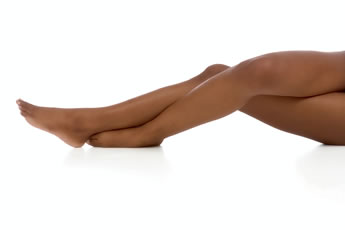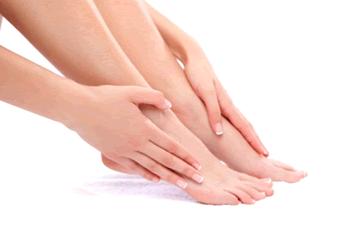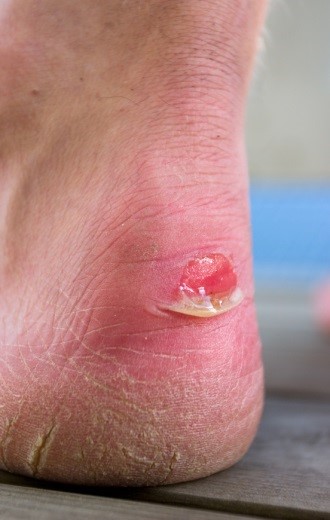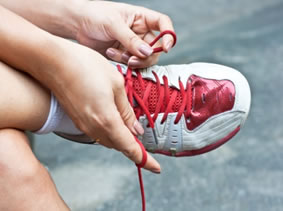Connect With Us
Items filtered by date: June 2016
See a Podiatrist for Corn Treatment
 Corns are characterized as thickened layers of skin, ranging from small to large, that form as a result of constant pressure to the skin. Corns can be removed with DIY methods, but it is recommended to see your doctor first. Treatments such as salicylic acid after filing your corns is one potential method in removing them. General prevention of corns involves wearing properly-fitting shoes.
Corns are characterized as thickened layers of skin, ranging from small to large, that form as a result of constant pressure to the skin. Corns can be removed with DIY methods, but it is recommended to see your doctor first. Treatments such as salicylic acid after filing your corns is one potential method in removing them. General prevention of corns involves wearing properly-fitting shoes.
If you have any concerns about your feet and ankles contact one of our podiatrists of The Podiatry Center, P.C.. Our doctors can provide the care you need to keep your pain free and on your feet.
Corns: What are they? And how do you get rid of them?
Corns can be described as areas of the skin that have thickened to the point of becoming painful or irritating. They are often layers and layers of the skin that have become dry and rough, and are normally smaller than calluses.
Ways to Prevent Corns
There are many ways to get rid of painful corns such as wearing:
- Well-fitting socks
- Comfortable shoes that are not tight around your foot
- Shoes that offer support
Treating Corns
Treatment of corns involves removing the dead skin that has built up in the specific area of the foot. Salicylic acid can help in getting rid of these corns because it dissolves keratin, which is the protein that makes up a good majority of corns. Podiatrists recommend that people with diabetes not use salicylic acid but should consult with their podiatrist regarding the treatment of corns.
If you have any questions, please feel free to contact our office located in Millburn, NJ. We offer the newest diagnostic tools and technologies to treat your foot and ankle needs.
Podiatrists Treat Conditions of the Feet and More
 Seeing your podiatrist should become a routine, as your podiatrist ensures that your feet are properly taken care of. Podiatrists treat foot and ankle ailments such as corns, calluses, heel pain, physical injuries, diabetic feet, arthritis, and more. Podiatrists also assist with evaluating your feet and can provide guidance on choosing the proper footwear. See your podiatrist especially if you’re having concerns about your feet or need early detection, diagnosis, and treatment.
Seeing your podiatrist should become a routine, as your podiatrist ensures that your feet are properly taken care of. Podiatrists treat foot and ankle ailments such as corns, calluses, heel pain, physical injuries, diabetic feet, arthritis, and more. Podiatrists also assist with evaluating your feet and can provide guidance on choosing the proper footwear. See your podiatrist especially if you’re having concerns about your feet or need early detection, diagnosis, and treatment.
If you are experiencing pain in the feet or ankles, don’t join the stubborn majority refusing treatment. Feel free to visit one of our podiatrists of The Podiatry Center, P.C.. Our doctors will assess your injury and provide you with quality treatment.
What is a Podiatrist?
Someone would seek care of a podiatrist when they have suffered a foot injury or have common foot ailments such as: heal spurs, bunions, arch problems, deformities, ingrown toenails, corns, foot and ankle problems etc.
Podiatric Treatment
A podiatrist will treat the problematic areas of the feet, ankle or lower leg by prescribing the following:
- physical therapy
- drugs
- perform surgery on lower extremity fractures
- orthotic inserts or soles
A common podiatric procedure a podiatrist will use is a scanner or force plate which will allow the podiatrist to know the designs of orthotics. Patients are then told to follow a series of tasks to complete the treatment. The computer will scan the foot a see which areas show weight distribution and pressure points. The podiatrist will read the analysis and then determine which treatment plans are available.
If you have any questions, please feel free to contact our office located in Millburn, NJ. We offer the newest diagnostic tools and technologies to treat your foot and ankle needs.
Blisters Form to Protect our Damaged Skin
 Also known as vesicles, blisters form when “the top layer of skin pulls away from lower layers and then fills with fluid.” Constant pressure and friction can lead to your skin breaking and blisters forming. Blisters are your body’s response to protecting and healing your skin, so avoid draining a blister if it is recently formed, as this can lead to infection. Different factors can affect why blisters form, including ill-fitting shoes that rub on your feet, or socks that retain sweat and moisture.
Also known as vesicles, blisters form when “the top layer of skin pulls away from lower layers and then fills with fluid.” Constant pressure and friction can lead to your skin breaking and blisters forming. Blisters are your body’s response to protecting and healing your skin, so avoid draining a blister if it is recently formed, as this can lead to infection. Different factors can affect why blisters form, including ill-fitting shoes that rub on your feet, or socks that retain sweat and moisture.
Blisters are prone to making everyday activities extremely uncomfortable. If your feet are hurting, visit one of our podiatrists of The Podiatry Center, P.C.. Our doctors will assess your injury and provide you with quality treatment.
Foot Blisters
Foot blisters develop as a result of constantly wearing tight or ill-fitting footwear. This happens due to the constant rubbing from the shoe, which can often lead to pain.
What are Foot Blisters?
A foot blister is a small fluid-filled pocket that forms on the upper-most layer of the skin. Blisters are filled with clear fluid and can lead to blood drainage or pus if the area becomes infected.
How do Blisters Form?
Blisters on the feet are often the result of constant friction of skin and material, usually by shoe rubbing. Walking in sandals, boots, or shoes that don’t fit properly for long periods of time can result in a blister. Having consistent foot moisture and humidity can easily lead to blister formation.
Prevention & Treatment
It is important to properly care for the affected area in order to prevent infection and ease the pain. Do not lance the blister and use a Band-Aid to provide pain relief. Also, be sure to keep your feet dry and wear proper fitting shoes. If you see blood or pus in a blister, seek assistance from a podiatrist.
If you have any questions, please feel free to contact our office located in Millburn, NJ. We offer the newest diagnostic tools and technologies to treat your foot and ankle needs.
What to Look for in the Right Footwear
 Investing in a quality pair of shoes that are comfortable is essential in ensuring that your feet are happy. Opt for shoes that have breathable, lightweight fabrics and that have proper arch and heel support. Wear the respective shoes for the physical activity or sport you will be doing. Avoid shoes that are too tight and avoid heels or elevation in the soles of the shoes. Look for footwear that gives your toes enough room to wiggle and change your shoes if they begin showing wear and tear marks.
Investing in a quality pair of shoes that are comfortable is essential in ensuring that your feet are happy. Opt for shoes that have breathable, lightweight fabrics and that have proper arch and heel support. Wear the respective shoes for the physical activity or sport you will be doing. Avoid shoes that are too tight and avoid heels or elevation in the soles of the shoes. Look for footwear that gives your toes enough room to wiggle and change your shoes if they begin showing wear and tear marks.
Finding a properly-fitting shoe is important in reducing injuries and preventing foot problems. For more information about treatment, visit one of our podiatrists of The Podiatry Center, P.C.. Our doctors will assess your injury and provide you with quality treatment.
Proper Shoe Fitting
A common concern when it comes to foot health, having properly fitted shoes can help prevent injuries to the foot. Out feet affect our posture and gait, which in turn affects the biomechanics and overall bodily structure. With 33 joints, 26 bones, and over 100 ligaments, the potential for serious injury is much greater than one realizes. Although the feet cease growth in adulthood, they still change shape as they mature. Here are some factors to consider when it comes to investing in proper fitting shoes:
- Be sure the shoes fit correctly right away
- Ensure the ball of your foot fits comfortably in the widest portion of the shoes
- Even though they may look fashionable, improper fitting shoes can either create adverse conditions or exacerbate existing ones you may already have
- Walk along a carpeted surface to ensure the shoes comfortably fit during normal activity
Keeping in mind how shoes fit the biomechanics of your body, properly-fitting shoes are vitally important. Fortunately, it is not difficult to acquire footwear that fits correctly. Be sure to wear shoes that support the overall structure of your body. Do your feet a favor and invest in several pairs of well-fitted shoes today.
If you have any questions, please feel free to contact our office located in Millburn, NJ. We offer the newest diagnostic tools and technologies to treat your foot and ankle needs.
Blog Archives
- June 2025
- May 2025
- April 2025
- March 2025
- February 2025
- January 2025
- December 2024
- November 2024
- October 2024
- September 2024
- August 2024
- July 2024
- June 2024
- May 2024
- April 2024
- March 2024
- February 2024
- January 2024
- December 2023
- November 2023
- October 2023
- September 2023
- August 2023
- July 2023
- June 2023
- May 2023
- April 2023
- March 2023
- February 2023
- January 2023
- December 2022
- November 2022
- October 2022
- September 2022
- August 2022
- July 2022
- June 2022
- May 2022
- April 2022
- March 2022
- February 2022
- January 2022
- December 2021
- November 2021
- October 2021
- September 2021
- August 2021
- July 2021
- June 2021
- May 2021
- April 2021
- March 2021
- February 2021
- January 2021
- December 2020
- November 2020
- October 2020
- September 2020
- August 2020
- July 2020
- June 2020
- May 2020
- April 2020
- March 2020
- February 2020
- January 2020
- December 2019
- November 2019
- October 2019
- September 2019
- August 2019
- July 2019
- June 2019
- May 2019
- April 2019
- March 2019
- February 2019
- January 2019
- December 2018
- November 2018
- October 2018
- September 2018
- August 2018
- July 2018
- June 2018
- May 2018
- April 2018
- March 2018
- February 2018
- January 2018
- December 2017
- November 2017
- October 2017
- September 2017
- August 2017
- July 2017
- June 2017
- May 2017
- April 2017
- March 2017
- February 2017
- January 2017
- December 2016
- November 2016
- October 2016
- September 2016
- August 2016
- July 2016
- June 2016
- May 2016
- April 2016
- March 2016
- February 2016
- January 2016
- December 2015
- November 2015
- October 2015
- September 2015
- August 2015
- July 2015
- June 2015
- May 2015
- January 2014
- December 2013
- November 2013
- October 2013
- September 2013
- August 2013
- July 2013
- June 2013
- May 2013
- April 2013
- March 2013
- February 2013
- January 2013
- December 2012
- November 2012
- October 2012
- September 2012
- August 2012
- July 2012
- June 2012
